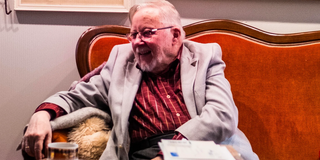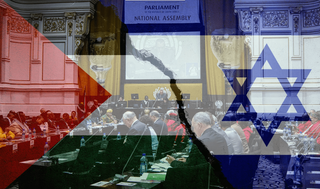News
Vytautas Landsbergis, the Pianist Who Helped to Sink the Soviet Union
Vytautas Landsbergis shrugs when asked why he went into politics. ‘It was a normal evolution since we were part of the developments. Freedom was a common idea, an achievable goal,’ he says of his momentous contribution to the cause of freedom and the end of the Cold War.

He is old now, 91 last October. He walks with a stoop. But his mind is as razor-sharp as ever.
You would never think the stippled-fawn apartment block in suburban Vilnius housed a former head of state, let alone one who played such a pivotal role in the end of the Soviet empire — no armed guard, no doorplate, no flag flapping, nothing to mark the venue as extraordinary. After we rang the wrong doorbell, a friendly elderly woman gathered her coat and boots and ushered us to the correct door. “It happens all the time,” she laughed.
The apartment was cosy, jumbled with photos and paintings, books and memorabilia of a long career; clutter that contrasted with the tenant’s absence of nostalgia. Dominating the living room and kitchen area was a grand piano, hinting at his lifelong pursuit.
Vytautas Landsbergis graduated from the Lithuanian Conservatory of Music (now the Lithuanian Academy of Music and Theatre) in 1955. The author of more than 30 books, his early works focused on the composer MK Čiurlionis, the subject of his PhD thesis. He became a professor at the conservatory in 1979 where he worked until 1990.
Then his life took a different direction. On 3 June 1988, he was elected to the steering group of Lietuvos Persitvarkymo Sąjūdis (Lithuanian Reform Movement), known simply as Sąjūdis. In November 1988 he became the chairperson of Sąjūdis at its inaugural conference.
He shrugs when asked why he went into politics. “It was a normal evolution since we were part of the developments. Freedom was a common idea, an achievable goal,” he says of his momentous contribution to the cause of freedom and the end of the Cold War.
On 6 August 1989, with the representatives of Lithuania and the diaspora, he signed the Gotland Communiqué on the Swedish island. This made their “vital goal … the restoration of an independent Lithuanian state”. It was a goal he was to oversee.
“We did not consider it a transfer of power from one system to another, but rather a return to our old system,” says the professor, referring to the 22 years of independence enjoyed by the three Baltic states — Latvia, Estonia and Lithuania — from 1918 until the Soviet invasion in 1940.
A pawn between Hitler’s and Stalin’s versions of totalitarianism, and adjacent to the Baltic Sea access of the port of Königsberg, later renamed Kaliningrad, Lithuania’s post-1940 history was especially bloody and violent.
“It was a court of two criminals,” Landsbergis says. “Though supporters of the Soviet Union make a difference between Hitler and Stalin,” he chuckles, “with Hitler being very bad, and Stalin less so, this did not change what had happened to us in 1940, which was totally illegal.”
More than 130,000 Lithuanians were deported to the Soviet Union from 1940 (including his wife and her family, who spent eight years in a Siberian camp), with some 28,000 dying in transport and another 20,000-25,000 in the camps.
Of the 200,000 Lithuanians arrested by Soviet authorities, more than 1,000 political prisoners were murdered in the basement of the NKVD (later KGB) Palace on Lukiškės Square in Vilnius. Add to this the estimated 21,500 partisans killed by the Soviets, and the 240,000 murdered by the Nazi regime which also deported 60,000 as slave labourers, and 15% of the Lithuanian population was effectively eliminated during these 50 years.
Incorporated into the Soviet system, the Baltic states were subjected to “fake elections, fake parliaments, and fake decisions”. But, Landsbergis says, the goal of Sąjūdis was not the breakup of the Soviet Union, nor was it a separatist movement.
“We wanted to be free of Soviet colonialism, to be free and independent again so that we can make our own choices, not having these made by Moscow.”
Changing of the guard
The opportunity came with the changing of the Soviet guard in Moscow. Leonid Brezhnev was succeeded by Yuri Andropov in November 1982, and Andropov was succeeded by Konstantin Chernenko in February 1984.
The music, however, continued playing. A year later, Mikhail Gorbachev was elevated to the position of general secretary of the Communist Party, the de facto leader in the Soviet Union, after Chernenko’s death. Twenty years younger than those he was replacing, Gorbachev had already spoken of the need for perestroika (or “restructuring”) of the economy, realising that the Soviet system was faltering.
Once in the top post, he introduced the idea of glasnost (or “openness”). While simultaneously pursuing reforms at home, he focused on lessening global tensions, concluding an arms limitation agreement with US President Ronald Reagan, improving ties with Beijing, and signalling to Kabul his intention to withdraw from the Soviet’s disastrous foray in Afghanistan. He created a Congress of People’s Deputies, whose members (including Landsbergis) were to be elected in a largely free vote, which would elect in turn the USSR Supreme Soviet to do the legislating.
But this was not Landsbergis’s goal. It was one step on a different path, not to consolidate Soviet rule but to undo it in the Baltic states.
“We wanted self-determination, the right to decide what we wanted to be, human rights, including the rights of the individual and the nation’s rights not to be enslaved, and free elections.”
Abandoning imperialism abroad and improving democracy at home did not mean that Gorbachev wanted to undo the Soviet Union. As the author Jonathan Steele argued, Gorbachev failed to appreciate why the Baltic nations wanted independence and “at heart, he was … a Russian imperialist”, a man who thought of the Soviet Union as being largely synonymous with Russia. Gorbachev’s actions were designed to keep the Soviet Union together.
The turning point was on 11 January 1990, when Gorbachev visited Vilnius to try to convince Landsbergis and others to not push for independence.
What was Gorbachev like to do business with?
“He was chosen for the special role of saving the Soviet Union,” says Landsbergis. “It was bankrupted at all levels, and could not survive. Reforms were thought about as the means of preserving their ‘essence’, their borders and the legitimation of their powers in their captured territories.”
Landsbergis described the Soviet system as one “where the military, Politburo and the KGB retained power and influence over us. Gorbachev was not a decision-maker as was presented in the West. He was given instructions.” He sees the last Soviet leader as a “prisoner” — of the system which promoted him and whose interests he served.
Landsbergis made the Soviet leader’s status clear. “He was welcomed as the great leader of a neighbouring country,” he chuckles.
The spark for Gorbachev’s visit to Vilnius was the adoption of a resolution by the Lithuanian Congress of People’s Deputies on 24 December 1989 that the occupation of the country was illegal and unlawful, though care was taken “to make Stalin guilty, not the entire Soviet nation. My position was to appeal then to Gorbachev to appeal our legal situation. He did not agree, but he could not deny the legal grounds.”
Independence and a Soviet crackdown
The next month, in February 1990, Sąjūdis dominated the elections, declaring the country independent from the USSR in March 1990.
Česlovas Juršėnas is a former speaker of the Seimas, the Lithuanian parliament and one of 124 signatories to the Act of the Re-Establishment of the State of Lithuania on 11 March 1990. He says that the act of breaking away was as significant as the fall of the Berlin Wall.
“Whereas Gorbachev saw it as an act of self-destruction since we had no natural resources, he had obviously received the wrong information about the depth of the feeling of Lithuanians. Even the most humble factory worker wanted to leave the Soviet Union. I had many disputes with Landsbergis, but not about whether we should be independent; rather about what would be done after it.”
A crackdown in January 1991 saw Soviet troops trying unsuccessfully to take control of key institutions in Vilnius, including the parliament, killing 14 people and injuring hundreds. It was Lithuania’s Tiananmen Square moment.
“I tried to call Gorbachev,” recalls Landsbergis of the time, “but they said he was sleeping. I got through to [Boris] Yeltsin, and he then immediately called Gorbachev. And Yeltsin said, ‘Stop these atrocities’.”
Lithuanians still hold Gorbachev responsible for this final outrage. “Lithuanians will not glorify Gorbachev. We will never forget the simple fact that his army murdered civilians to prolong his regime’s occupation of our country. His soldiers fired on our unarmed protesters and crushed them under his tanks. That is how we will remember him,” said the country’s foreign minister, Gabrielius Landsbergis, the grandson of the pro-democracy leader, on the last Soviet leader’s death in August 2022.
Lithuania’s defence minister, Arvydas Anušauskas, who in a previous life researched underground resistance to the Soviet rule, went even further, calling Gorbachev “a criminal”.
It was not just the Soviet leader’s reaction that disappointed the Lithuanians. Western leaders were similarly reluctant to give support to independence movements within the USSR, walking a line between their fear of the Soviets and the rights of the Lithuanians and others.
“The West told us that Moscow had to give us our independence, that the ‘key’ to our independence lay in Moscow. It’s not unlike the situation today in Ukraine,” Landsbergis says. ‘The West is supporting Ukraine but not too much. Same as they did for us.” That chuckle again.
“Gorbachev used to say to me personally, ‘Forget your dreams; you will never have your independence.’ He wanted to convey that he was the master. But he wasn’t. His country was weak and disintegrating.”

And yet he had to be cautious. “We had to make it not about the Soviet Union, but rather about us, about the Baltic states. We did not claim the abolition of the Baltic states or of communism. We just wanted out of that business.”
Gorbachev tried to use the argument that Lithuania was divided, that part wanted to stay with the Soviet Union, an echo of the tactics today in Georgia, Ukraine and Moldova.
“Perhaps this was a pretext to use force. But these efforts failed. I asked Gorbachev, ‘Are you a continuation of Stalin?’ He wanted to play a role as a reformer, but you could not reform a system in which we remained prisoners.”
End of the Soviet Union
While the dissolution of the Soviet Union may not have been the intention and it was strategically wise not to seek that objective since it might have raised the stakes to unacceptable limits, it was the outcome. Freedom in the Baltic states was the beginning of a rapid end to the Soviet Union.
The abortive hardliner coup in Moscow in August 1991 aimed at curtailing Gorbachev’s restructuring provided the political opportunity for the rapid implementation of Baltic independence. Gorbachev gave way to his opponent Yeltsin, who suspended Communist Party rule the same month.
The following month the three Baltic states were admitted to the United Nations, once more recognised by their peers as independent nations.
“In the event, we went all the way, not for some freedoms, but for everything, total freedom,” Landsbergis says. “Gorbachev could not be convinced. He was not a free man due to his communist education and the environment which had appointed him. It was not Gorbachev and not Yeltsin who gave us our independence,” he says, “but the will of a nation striving for liberation in spite of terror, in spite of bloodshed.”
Today Lithuanians are outspoken in their support for Ukraine, and for democracy elsewhere. “We know only too well the price of foreign domination,” says Asta Skaisgirytė, the chief adviser to the president of Lithuania.
The narrative was overall about freedom but key events were important, starting from the independence process itself and membership of the European Union and Nato in 2002. There were unexpected moments along the way, including the Lithuanian basketball team winning a bronze medal at the 1992 Barcelona Olympics.
Sponsored by the Grateful Dead, and sporting tie-dye team kit, the medal result was part payback to Russia for the 50 years of occupation by a team “that fulfilled the dream of a nation”. Several of the star players had won gold with the Soviet team four years earlier.
“Lithuania really won that gold medal in 1988 for the USSR, but its name wasn’t there. It was one more untruth that we had to fix,” Landsbergis recalls.
The Lithuanian passage was seemingly unstoppable in returning the country to its pre-war state. The Soviet period was seen as an aberration.
“In the Soviet Union we were considered as an advanced Western better-developed region,” recalls Andrius Kubilius, twice a prime minister in Lithuania, a physicist who unwittingly found himself thrust into a political role. “For us, however, we went from being first among our peers to last among the Western camp, from the best to the worst in one step.”
The sage, steadying hand remains. Of these troubled times, when the world seems to be changing rapidly on so many fronts, demanding a continuous reassessment of risk, Landsbergis says, “As democrats, we must believe we still have choice.”
The remedy to today’s seemingly increasing distance, especially of young people, from democracy lies in good politics, not in an obsessive search for popularity or in partisanship, but finding the appeal of participation, as attendees at the Future of Democracy forum held this past week in Vilnius were reminded.
Of course, Landsbergis would never, ever claim that he helped to sink the Soviet Union. His modesty is the ultimate mark of a great man.
This article originally appeared on Daily Maverick.
Photo: Richard Harper


